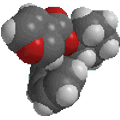 |
Chapter 27: Amino Acids, Peptides and Proteins |
 |
Alkylation of an Acetamidomalonate

Reaction type: Nucleophilic Substitution then amide and ester hydrolysis
and finally decarboxylation (!)
Summary
-
Reagents : (1) NaOEt, (2) alkyl halide, then (3) aq. acid / heat
-
Although this looks complex, it is an application of reactions seen previously:
-
The malonate derivative is treated with a base to form the nucleophilic
enolate that then reacts with the alkyl halide.
-
Note that the same acetamido malonate can be used to form any
primary α-amino acid.
-
Hydrolysis of the malonate ester and the amide forms an intermediate
amino dicarboxylic acid that decarboxylates to give the α-amino
acid.
QUESTIONS
Related Reactions
